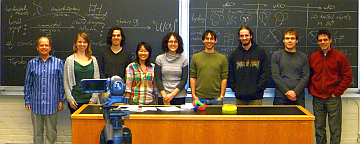WKO
| DBN: Publications: WKO / Navigation | ||||||||||||||||||||||||||||||||||||||||||||
| Wideo Companion The wClips Seminar is a series of weekly wideotaped meetings at the University of Toronto, systematically going over the content of the WKO paper section by section. Announcements. small circle, UofT, LDT Blog (also here). Email Dror to join our mailing list! Resources. How to use this site, Dror's notebook, blackboard shots.
| ||||||||||||||||||||||||||||||||||||||||||||
Finite Type Invariants of W-Knotted Objects: From Alexander to Kashiwara and Vergne
Joint with Zsuzsanna Dancso
This paper was split in two and became the first two parts of a four-part series (WKO1, WKO2, WKO3, WKO4). The remaining relevance of this page is due to the series of videotaped lectures (wClips) that are linked here.
Download WKO.pdf: last updated ≥ May 5, 2014. first edition: September 27, 2013. The arXiv:1309.7155 edition may be older.
Abstract. w-Knots, and more generally, w-knotted objects (w-braids, w-tangles, etc.) make a class of knotted objects which is wider but weaker than their "usual" counterparts. To get (say) w-knots from u-knots, one has to allow non-planar "virtual" knot diagrams, hence enlarging the the base set of knots. But then one imposes a new relation, the "overcrossings commute" relation, further beyond the ordinary collection of Reidemeister moves, making w-knotted objects a bit weaker once again.
The group of w-braids was studied (under the name "welded braids") by Fenn, Rimanyi and Rourke [FRR] and was shown to be isomorphic to the McCool group [Mc] of "basis-conjugating" automorphisms of a free group - the smallest subgroup of that contains both braids and permutations. Brendle and Hatcher [BH], in work that traces back to Goldsmith [Gol], have shown this group to be a group of movies of flying rings in . Satoh [Sa] studied several classes of w-knotted objects (under the name "weakly-virtual") and has shown them to be closely related to certain classes of knotted surfaces in . So w-knotted objects are algebraically and topologically interesting.
In this article we study finite type invariants of several classes of w-knotted objects. Following Berceanu and Papadima [BP], we construct homomorphic universal finite type invariants of w-braids and of w-tangles. We find that the universal finite type invariant of w-knots is more or less the Alexander polynomial (details inside).
Much as the spaces of chord diagrams for ordinary knotted objects are related to metrized Lie algebras, we find that the spaces of "arrow diagrams" for w-knotted objects are related to not-necessarily-metrized Lie algebras. Many questions concerning w-knotted objects turn out to be equivalent to questions about Lie algebras. Most notably we find that a homomorphic universal finite type invariant of w-knotted foams is essentially the same as a solution of the Kashiwara-Vergne [KV] conjecture and much of the Alekseev-Torossian [AT] work on Drinfel'd associators and Kashiwara-Vergne can be re-interpreted as a study of w-knotted trivalent graphs.
The true value of w-knots, though, is likely to emerge later, for we expect them to serve as a warmup example for what we expect will be even more interesting - the study of virtual knots, or v-knots. We expect v-knotted objects to provide the global context whose projectivization (or "associated graded structure") will be the Etingof-Kazhdan theory of deformation quantization of Lie bialgebras [EK].
Related Mathematica Notebooks. "The Kishino Braid" (Source, PDF), "Dimensions" (Source, PDF), "wA" (Source, PDF), "InfinitesimalAlexanderModules" (Source, PDF).
Related talks. Oberwolfach-0805, MSRI-0808, Northeastern-081028, Trieste-0905, Bonn-0908, Caen-1206.
Links. SandersonsGarden.html.
Related Scratch Work is under Pensieve: WKO and Pensieve: Arrow_Diagrams_and_gl(N).
References.
[AT] ^ A. Alekseev and C. Torossian, The Kashiwara-Vergne conjecture and Drinfeld's associators, arXiv:0802.4300.
[BP] ^ B. Berceanu and S. Papadima, Universal Representations of Braid and Braid-Permutation Groups, arXiv:0708.0634.
[BH] ^ T. Brendle and A. Hatcher, Configuration Spaces of Rings and Wickets, arXiv:0805.4354.
[EK] ^ P. Etingof and D. Kazhdan, Quantization of Lie Bialgebras, I, Selecta Mathematica, New Series 2 (1996) 1-41, arXiv:q-alg/9506005.
[FRR] ^ R. Fenn, R. Rimanyi and C. Rourke, The Braid-Permutation Group, Topology 36 (1997) 123-135.
[Gol] ^ D. L. Goldsmith, The Theory of Motion Groups, Mich. Math. J. 28-1 (1981) 3-17.
[KV] ^ M. Kashiwara and M. Vergne, The Campbell-Hausdorff Formula and Invariant Hyperfunctions, Invent. Math. 47 (1978) 249-272.
[Mc] ^ J. McCool, On Basis-Conjugating Automorphisms of Free Groups, Can. J. Math. 38-6(1986) 1525-1529.
[Sa] ^ S. Satoh, Virtual Knot Presentations of Ribbon Torus Knots, J. of Knot Theory and its Ramifications 9-4 (2000) 531-542.










